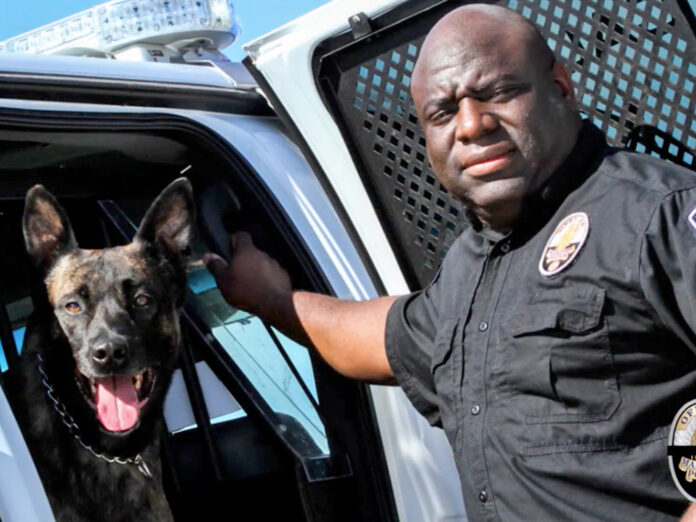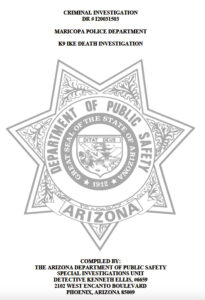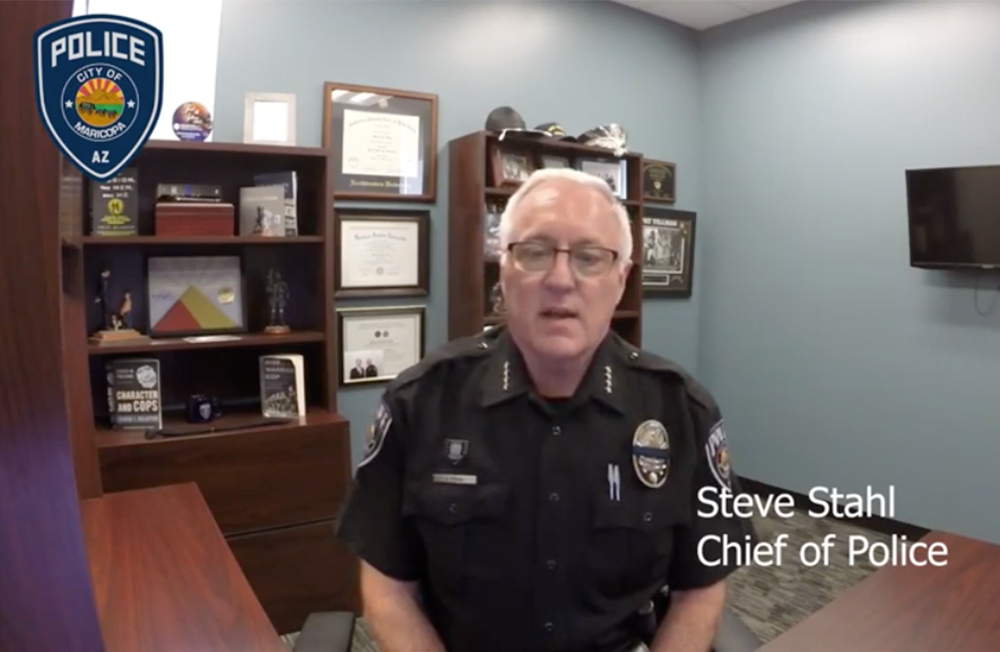
Four months after the death of Maricopa K-9 officer Ike, the state Department of Public Safety has released a report on its criminal investigation into the “heat-related incident” that took his life.
The agency’s 136-page, redacted report, which offered no recommendations for disciplinary action, has been sent to the Pinal County Attorney’s Office for review and findings.
PREVIOUS COVERAGE: State investigates death of K-9 Ike
The report on the June 26 incident paints a chaotic situation in the late afternoon hours of a day when the temperature reached 108 degrees.
Ike, a 9-year-old Dutch Shepherd, was in the rear kennel of a K-9 unit parked in a lot at police headquarters when his handler, Maricopa Officer Craig Curry, checked on him about 4:40 p.m. Curry discovered the engine of the Ford F-150 truck was not running and opened the rear door to discover his K-9 partner “breathing heavily with his tongue out and his eyes were glossy,” according to the report.
Curry and other officers took immediate action to cool the dog down, then sped the ailing canine to a local veterinarian for emergency treatment for hyperthermia, or heat stroke. Once his temperature was lowered, Ike was transferred via ambulance to a veterinary emergency hospital in Gilbert, where he spent several hours stabilizing before his condition degraded.
At 3:45 a.m. June 27, Ike, a veteran of the department since 2013, was humanely euthanized by hospital staff, a procedure authorized by MPD command staff and attended by Curry and other department personnel. A necropsy was performed and he was cremated.
As Ike was trapped in the hot K-9 vehicle a day earlier, Curry was meeting with the department’s commander about planning his partner’s retirement. Instead, Ike died in the line of duty.
As Curry walked into the building, his ballistic vest and duty belt, with firearm and pager for the emergency heat alarm system, were left behind in the vehicle.
The report was the first word on the events leading to Ike’s death since Police Chief Steve Stahl recorded a “Critical Incident Notification” video posted on the department’s YouTube channel on June 29. He said his K-9 officer had “suffered a heat-related incident.”
“We cannot release details at this time, but will do so when they become available,” he explained in the video. “We understand our commitment to you includes keeping our trust and we pledge this incident will be no different.”
Stahl referred the matter to DPS for criminal investigation.

The report from the agency’s Special Investigation Unit includes:
• Investigative and supplemental reports by DPS detectives
• A transcript of a 32-minute voluntary interview with Curry, who was accompanied by his attorney
• Interviews with MPD supervisors and officers
• Documents from the two veterinary hospitals detailing the dog’s condition, treatment and their communications with MPD
• A report detailing an inspection of Curry’s K-9 vehicle by a Ford dealership in Chandler
• An inspection report by a Florida company that sold the department the K-9 safety alarm system outfitted on Curry’s vehicle, and
• Descriptions of surveillance and body-worn camera video from before and during the incident
The redacted report contains no obvious redactions.
‘I NEED YOUR HELP … IT’S IKE’
Curry, who has been with MPD since graduating Mesa Police Academy in 2008 and a K-9 officer since 2013, was Ike’s handler from the beginning.
According to the report, Curry and Ike were scheduled to work the 7 p.m. to 4 a.m. shift on June 26 after taking a comp day a day earlier. But they arrived at MPD headquarters at 2:53 p.m. for Curry’s meeting with Cmdr. Michael Campbell to discuss the department’s K-9 program, Ike’s retirement and his eventual replacement.
Curry told investigators that he parked MPD vehicle #492 in the south parking lot, exiting the vehicle with the engine running, the air conditioning on the third fan speed and on the coldest temperature setting, all the windows rolled up and the doors locked. Ike was in the built-in kennel in the rear area of the truck.
As Curry walked into the building four minutes later, his ballistic vest and his duty belt, with firearm, were left behind in the vehicle, according to the investigation. The pager for the vehicle’s K-9 emergency heat alarm system – known as the AceK-9 Hot-N-Pop Pro – was still attached to the vest or duty belt.
The meeting with Campbell started late – about 3:30 p.m. – and they took a break about 4:40 p.m. Curry left the building to check on Ike, and as he approached the truck realized the engine was not running. He opened the rear door and found Ike in bad shape.
According to the report, Curry attempted to start his vehicle three times.
“With the first attempt, the vehicle’s engine did not turn over and made a clicking sound like the battery was dead,” DPS investigator Kenneth Ellis Jr. wrote in the report. “With the second attempt, the vehicle’s engine did not turn over, the electronics inside the vehicle activated, and the K-9 heat alert system in the vehicle chirped like it was starting up. The vehicle then lost all power. With the third attempt, the vehicle’s engine did not turn over and no electronics activated.”
Curry headed back inside to get help.
Investigators interviewed three officers – Officers Chance Jordan and Timothy Helin and Sgt. Kevin Mellor, who was Curry’s supervisor for the last six months – who lent their assistance in the frantic moments after the tragic discovery.
As Curry re-entered the building, he said, “Chance, Chance, I need your help. I need your help, follow me, follow me,” according to a DPS interview with Jordan. Jordan followed Curry outside as the K-9 handler said “It’s Ike. It’s Ike.”
Chance said Curry told him to get his patrol vehicle and pull it alongside the F-150 truck. Then, Curry opened the rear driver side door before running to the other side of his vehicle and opening the rear passenger side door. Chance said he and Curry moved Ike into the back seat of Chance’s truck and drove to the rear parking lot, where they carried the K-9 into a shaded area and began to “water him down” with a garden hose.
Helin, who had also followed Curry into the parking lot after hearing his calls for help, soon returned to the building to grab bags of ice and took them to the rear lot to help bring down Ike’s temperature.
Mellor also followed Curry and the other officers into the parking lot, observing Jordan carrying the dog, telling investigators Ike’s body was limp, his “whole body was shaking.” He asked Curry who he needed to call, but Curry did not respond to the question.
Mellor called Maricopa Wells Animal Hospital to ask if he could bring in a canine that was potentially in shock. Told to bring in the animal, Mellor said he directed Curry and Jordan to take Ike to the animal hospital with a Code 3 response, meaning with lights and siren.
Investigators asked Jordan, Helin and Mellor if they recalled if the vehicle’s windows were up or down. Jordan and Helin each responded they did not recall if the rear passenger door window was up or down nor if the rear window fan was operating. Mellor, too, said he did not recall if the windows of Curry’s patrol vehicle were up or down.

TWO KEY DISCOVERIES
The question is pertinent to the investigation because if the K-9 vehicle was left running and the engine suddenly stalled and turned off, the AceK-9 Hot-N-Pop Pro system outfitted on the truck was programmed to minimize the health danger to the K-9 by lowering the rear windows, turning on a rear fan, honking the horn in an SOS pattern and activating a pager on the K-9 officer’s vest to alert of a dangerous situation.
But an inspection by John Johnson, the inventor of the AceK-9 Hot-N-Pop Pro (HNP) system, found a number of problems with the way the equipment was maintained.
Two key discoveries made by Johnson involved the HNP pager and its transmitter, according to a July 5, 2020 report he emailed to Ellis.
When Johnson located the pager transmitter, behind the driver’s seat, its antenna connector was unscrewed and disconnected, which would have limited the range of its signal to the pager receiver worn by the handler to less than 100 feet from the vehicle, he wrote in his report. Properly connected to the antenna, the transmitter could ping the receiver from a range of 1,000 to 3,000 feet. A combination Pager/Door Popper roof antenna was missing as well.
Johnson found the pager in the driver’s door, its power switch set to the “vibrate only” position. Its batteries were dead. In the passenger door he located spare batteries which, installed into the unit, put the pager in working status. Testing of the system, heat alarms and low voltage alarms showed the system worked properly; both rear windows rolled down, the fan spun and the horn honked.
“If it is the case, upon the return of the Handler, that the windows were not down but everything was dead in the vehicle, then there is something mechanically/electrically wrong with the vehicle,” Johnson wrote.
“If it is the case, upon the return of the Handler, that the windows were down, then the Alarm had activated most likely by heat first which would have rolled down both rear windows, activated the fan thus providing active ventilation, and horn honking as long as the battery was above the low voltage level. Then it would have continued in the ‘Low Battery Voltage Alarm’ mode extending the alert until the battery expired. The Pager would have been triggered every 30 seconds if it had been operational.”
During his interview with Curry, Ellis asked Curry a series of questions about how the heat alert system works. Curry explained the windows drop and fan comes on when the system activates.
Ellis asked, “Have you had any issues with that system recently?” but never asks Curry about the condition of the HNP equipment in his vehicle.
“No-no,” Curry answered.
‘IDLED DOWN, LOST POWER’
Curry told investigators his vehicle had a recent, intermittent history of shutting off when making a turn. “As you’re drivin’ it will idle down and lose power,” he told Ellis in a July 9 interview.
“At one point, I was turnin’ the corner,” Curry explained, according to a transcript of the interview. “Idled down, lost power. Shifted it up. I shifted to neutral ‘cause I didn’t want to lock the (brakes). Neutral started right back up. Put it back in drive and it continues to drive.”
Curry does not say how many times his vehicle lost power, and he is not asked by Ellis, saying that when it happened, he would let fleet management know about it.
The most recent occurrence was in the beginning of May. The patrol vehicle was taken to be inspected at Highway 387 Auto Service in Casa Grande, which noted on the invoice they were asked to “diag(nose) why vehicle keeps dying when making turn.”
A fuel pump fuse was replaced and a new fuel pump relocation harness was installed, according to service records dated May 11, the day Curry picked up the vehicle.
“I was informed that,” Hey, we changed the fuel pump harness, or fuel pump fuse, an air mass sensor….” Curry told Ellis in the interview, according to the transcript. “I don’t know if that was the problem, ‘cause I never asked. I didn’t say – was that the problem they found, I don’t know.”
Curry told Ellis the problem had not reoccurred since the car was picked up from Highway 387.
About 5:30 p.m. on the day of the incident, Officer Daniel Rauch received the keys to Curry’s vehicle and started it up with no problem, the investigative report said. When he arrived to secure the vehicle, he told Ellis, all windows were rolled up.
It was towed to MPD’s property and evidence vehicle lot and impounded with evidence tape seals on the doors, hood and truck bed.
Five days later, on July 1, the vehicle was towed to Earnhardt Ford in Chandler, where it was inspected by its shop foreman. The vehicle’s engine would not turn over by itself, and when a jump box was connected to the battery, the heat alert system activated.
In his notes on the invoice provided to investigators, the mechanic noted “unable to find accurate cause of engine shut down at this time.”
Stahl did not immediately return a call Thursday night for comment on the DPS report.
Mayor Christian Price said Thursday he had not yet seen the report.

![City gave new manager big low-interest home loan City Manager Ben Bitter speaks during a Chamber of Commerce event at Global Water Resources on April 11, 2024. Bitter discussed the current state of economic development in Maricopa, as well as hinting at lowering property tax rates again. [Monica D. Spencer]](https://www.inmaricopa.com/wp-content/uploads/2024/04/spencer-041124-ben-bitter-chamber-property-taxes-web-218x150.jpg)

![3 things to know about the new city budget Vice Mayor Amber Liermann and Councilmember Eric Goettl review parts of the city's 2024 operational budget with Mayor Nancy Smith on April 24, 2024. [Monica D. Spencer]](https://www.inmaricopa.com/wp-content/uploads/2024/04/spencer-042424-preliminary-budget-meeting-web-218x150.jpg)








![Alleged car thief released without charges Phoenix police stop a stolen vehicle on April 20, 2024. [Facebook]](https://www.inmaricopa.com/wp-content/uploads/2024/04/IMG_5040-218x150.jpg)

![City gave new manager big low-interest home loan City Manager Ben Bitter speaks during a Chamber of Commerce event at Global Water Resources on April 11, 2024. Bitter discussed the current state of economic development in Maricopa, as well as hinting at lowering property tax rates again. [Monica D. Spencer]](https://www.inmaricopa.com/wp-content/uploads/2024/04/spencer-041124-ben-bitter-chamber-property-taxes-web-100x70.jpg)

![3 things to know about the new city budget Vice Mayor Amber Liermann and Councilmember Eric Goettl review parts of the city's 2024 operational budget with Mayor Nancy Smith on April 24, 2024. [Monica D. Spencer]](https://www.inmaricopa.com/wp-content/uploads/2024/04/spencer-042424-preliminary-budget-meeting-web-100x70.jpg)
